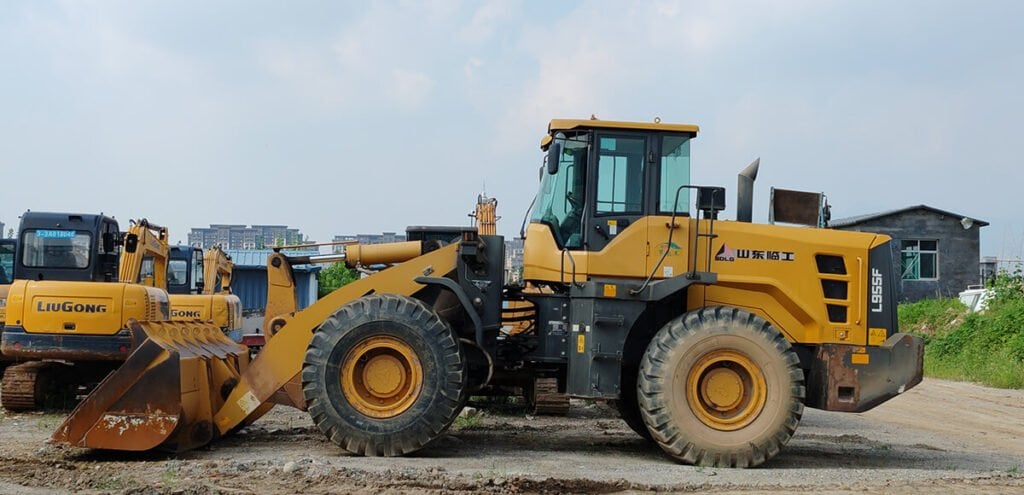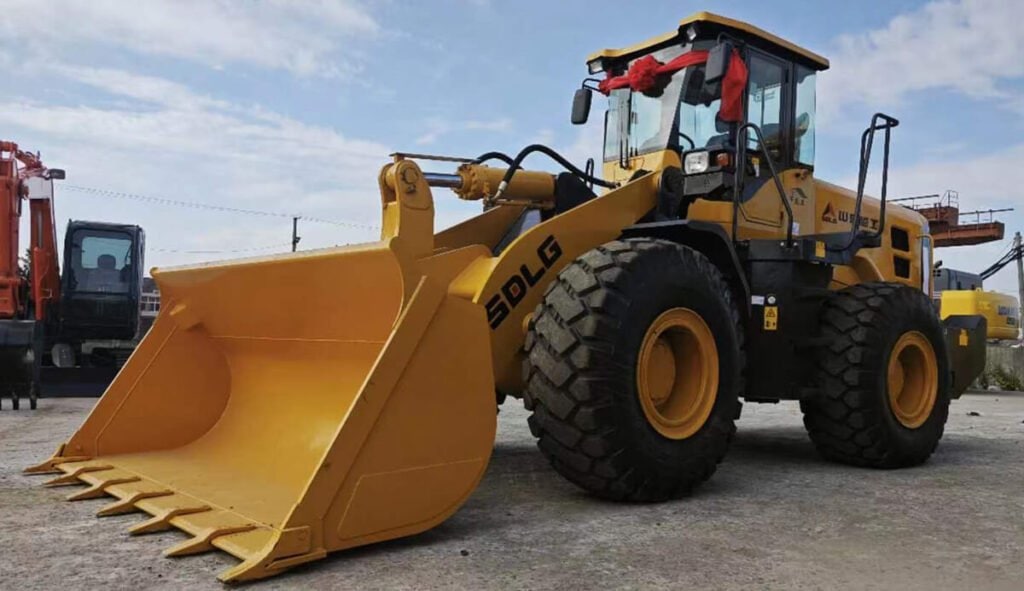Imagine stepping into the cab of a state-of-the-art loader. The moment you sit down, you’re greeted by a world of cutting-edge loader technology that has transformed how these mighty machines operate.
From the moment you start the engine, you’ll notice how far loader technology has come in recent years.
Let’s explore the advancements that have revolutionized the construction and mining industries, focusing on the loader technology that have made today’s loaders smarter, safer, and more sustainable.

Loader Technology 1. Hybrid and Electric Powertrains
You turn the key, and instead of the roar of a diesel engine, you hear the whisper-quiet hum of an electric motor. Electric Loaders have become a game-changer in urban construction sites and underground mines. They produce zero local emissions, reducing air pollution and noise levels that could disturb nearby communities. Not only do they provide a cleaner environment, but they also cut down on operational costs thanks to cheaper electricity compared to diesel fuel prices.
As you maneuver the loader, you feel the smooth transition between electric and combustion modes if it’s a Hybrid Loader. These machines combine the best of both worlds, offering the power needed for tough jobs while minimizing fuel consumption and emissions. The ability to switch between power sources means you can work efficiently in various conditions, whether you’re dealing with heavy loads or navigating tight spaces.
Loader Technology 2. Automation and Robotics
With a tap on the screen, you initiate the Autonomous Operation mode. Your loader now moves independently, guided by GPS and onboard sensors. Autonomous loaders can work around the clock, increasing productivity without the need for operator shifts. They follow pre-programmed paths and perform tasks with precision, reducing the risk of errors that could occur with human fatigue.
Even though you’re not controlling the loader directly, you still have full oversight. Remote Control technology lets you monitor and adjust the loader’s actions from a distance. This is especially useful in hazardous environments where sending personnel could be risky. The ability to operate from a safe location enhances job safety and reduces labor costs.
Loader Technology 3. Telematics and IoT Integration
As you glance at the dashboard, you see real-time data streaming from various sensors around the loader. Telematics Systems provide insights into the machine’s health and performance, allowing for predictive maintenance. Issues can be detected early, preventing breakdowns and saving on costly repairs.
The IoT Integration extends beyond the loader itself. It connects with other equipment and the central management system, creating a network of information. This connectivity enables smarter logistics planning, optimized fleet utilization, and streamlined communication between machines and operators.

Loader Technology 4. Fuel Efficiency and Emissions Reduction
With every move, you appreciate the smoothness of the engine. Engine Enhancements have led to more efficient powerplants that comply with strict emission regulations. Turbocharging and direct injection technologies increase fuel economy while reducing harmful pollutants. Exhaust treatment systems like diesel particulate filters and selective catalytic reduction further clean the exhaust gases, making your loader a greener choice.
Alternative fuels like Biodiesel and Hydrogen are gaining traction in the industry. These fuels emit fewer greenhouse gases and can be used in modified engines to achieve even greater reductions in environmental impact. The move towards cleaner energy is not just good for the planet; it also aligns with corporate social responsibility goals and regulatory requirements.
Loader Technology 5. Enhanced Safety Features
Safety is paramount, and modern loaders come equipped with features designed to protect both operators and workers on the ground. Improved Visibility is achieved through the use of multiple cameras, sensors, and strategically placed mirrors. Large windows provide panoramic views, reducing blind spots and enhancing awareness of the surrounding area.
Safety Sensors detect obstacles and alert you before a collision occurs. Proximity alarms warn you when you’re getting too close to structures or other vehicles. Collision avoidance systems can even take control to prevent accidents, ensuring a safer work environment.
Loader Technology 6. Advanced Hydraulics and Electronics
Operating the loader feels almost effortless thanks to the Digital Hydraulic Systems. These systems allow for precise control of movements, making the loader more agile and responsive. You can perform complex tasks with finesse, whether you’re handling delicate materials or executing intricate maneuvers.
Electronic Controls coordinate the various functions of the loader, ensuring that each component works harmoniously. The electronic control module (ECM) acts as the brain of the machine, managing everything from engine speed to auxiliary hydraulics. This integration leads to smoother operation and better performance across the board.

Loader Technology 7. Durability and Maintenance
Maintenance is a critical aspect of owning a loader, and recent designs have focused on making these machines more durable and easier to maintain. Longer Life Cycle is achieved through the use of robust materials and superior engineering practices. Loaders are built to withstand harsh conditions and last longer, reducing the frequency of major overhauls.
Easier Maintenance is facilitated by quick-access panels and centralized diagnostic systems. Routine checks and servicing can be performed more efficiently, minimizing downtime and keeping the loader ready for action. The ability to identify issues quickly and address them promptly translates into higher uptime and lower operational costs.
Loader Technology 8. Operator Comfort and Ergonomics
As you settle into the comfortable seat, you appreciate the attention to detail in the Cab Design. Climate control systems keep the interior at a comfortable temperature, regardless of external conditions. Ergonomic seats provide support during long hours of operation, reducing fatigue and increasing concentration.
User-Friendly Interfaces make it easy to interact with the loader’s systems. Intuitive controls and displays guide you through the operation, minimizing the learning curve for new operators. The result is a more productive work environment where operators can focus on their tasks without distractions.

Loader Technology 9. Multi-Functionality
One of the most exciting aspects of modern loaders is their Versatility. With the ability to accept a wide range of attachments, a single loader can perform multiple roles on the job site. Buckets, forks, brooms, and snow plows are just a few examples of the attachments that can transform the loader into a specialized tool for different applications.
Adaptive Systems allow the loader to adjust its settings according to the terrain and load being handled. Whether you’re working on a rough construction site or a smooth warehouse floor, the loader adapts seamlessly, maintaining optimal performance under varying conditions.
Loader Technology 10. Smart Maintenance and Diagnostics
Keeping your loader in top condition is easier than ever with the latest Predictive Maintenance technologies. Advanced diagnostics systems continuously monitor the health of the machine, identifying potential issues before they become serious. This proactive approach to maintenance saves time and money by preventing unscheduled downtime.
Remote Diagnostics enable technicians to troubleshoot problems without needing to be physically present. Through secure connections, experts can access the loader’s systems, analyze data, and recommend solutions that can often be implemented remotely. This reduces the need for on-site visits and accelerates the resolution of issues.

خاتمة
The advancements in loader technology represent a significant leap forward in the construction and mining industries. From hybrid and electric powertrains to automation and robotics, these innovations have made loaders smarter, safer, and more sustainable. Telematics and IoT integration provide real-time insights into machine performance, while fuel efficiency and emissions reduction efforts address environmental concerns. Enhanced safety features, advanced hydraulics, and ergonomic designs contribute to a more productive and comfortable working environment. Durability and maintenance improvements ensure longevity and ease of service. The multi-functionality and smart maintenance capabilities of modern loaders demonstrate a commitment to meeting the diverse needs of today’s construction and mining operations.
As you exit the cab, you reflect on the journey that brought us to this point—a testament to human ingenuity and the relentless pursuit of excellence. Loader technology continues to evolve, and the future promises even more remarkable developments that will shape the landscape of our industries for generations to come.

Summary: Loader technology has advanced significantly, offering benefits such as hybrid and electric powertrains, automation and robotics, telematics and IoT integration, improved fuel efficiency and emissions reduction, enhanced safety features, advanced hydraulics and electronics, increased durability and ease of maintenance, improved operator comfort and ergonomics, multi-functionality, and smart maintenance and diagnostics. These innovations contribute to a more efficient, safe, and sustainable construction and mining sector.